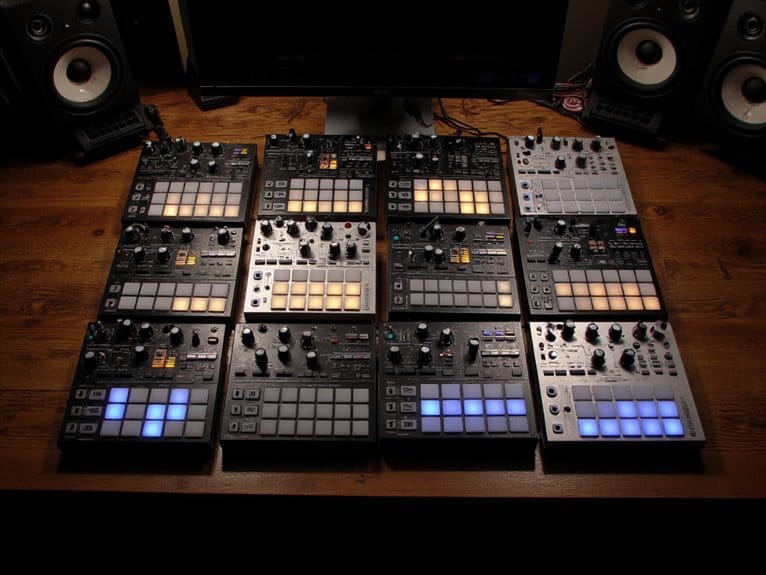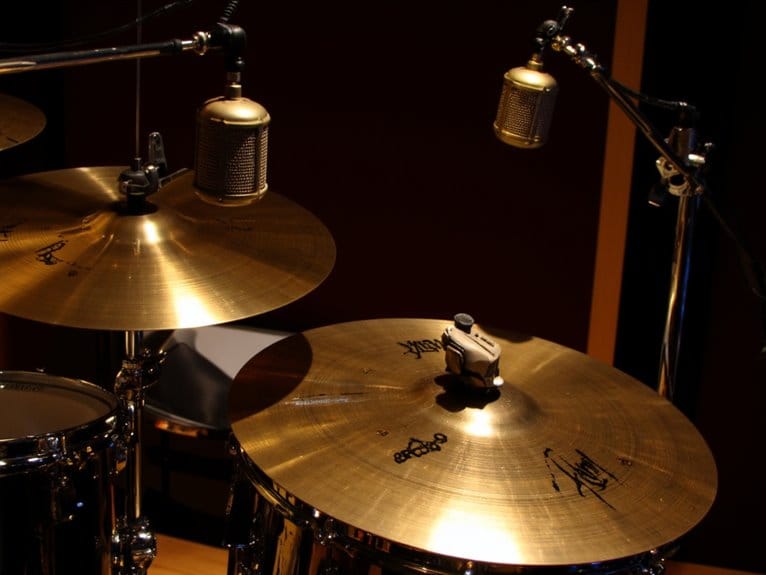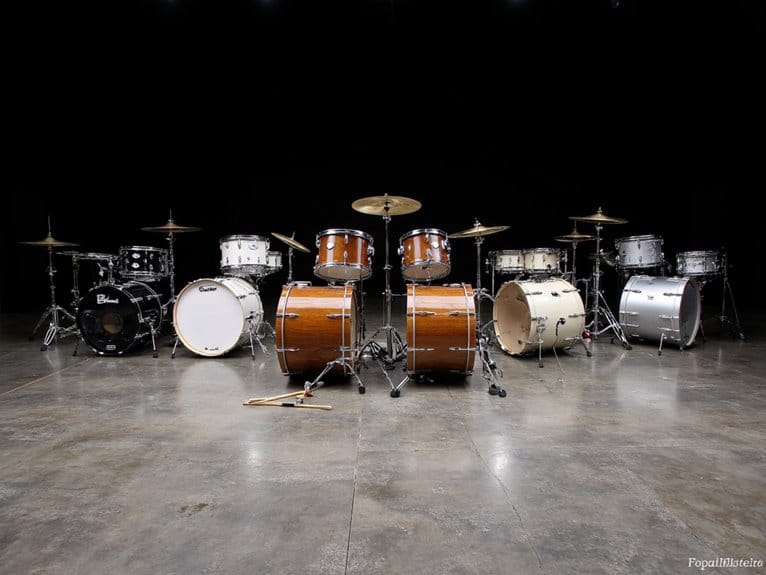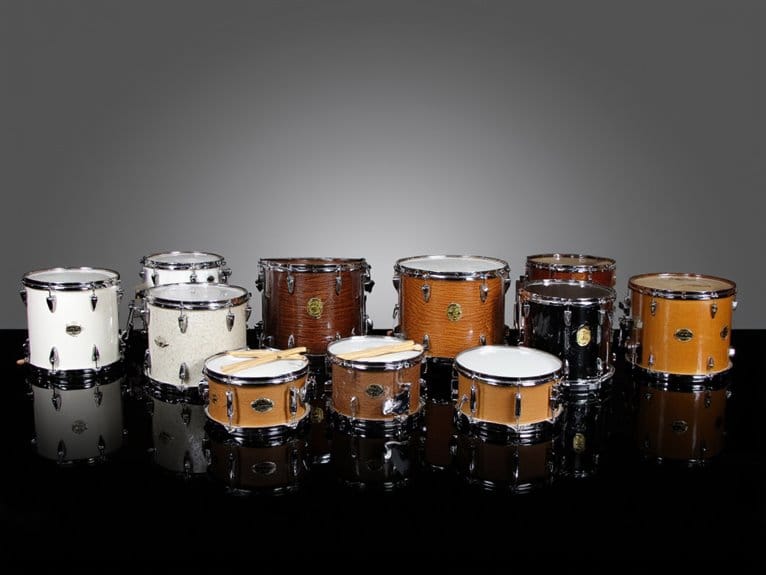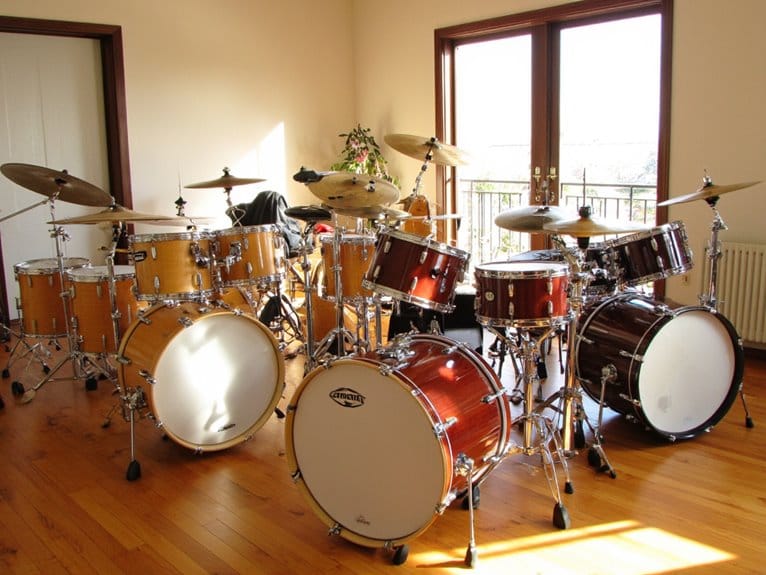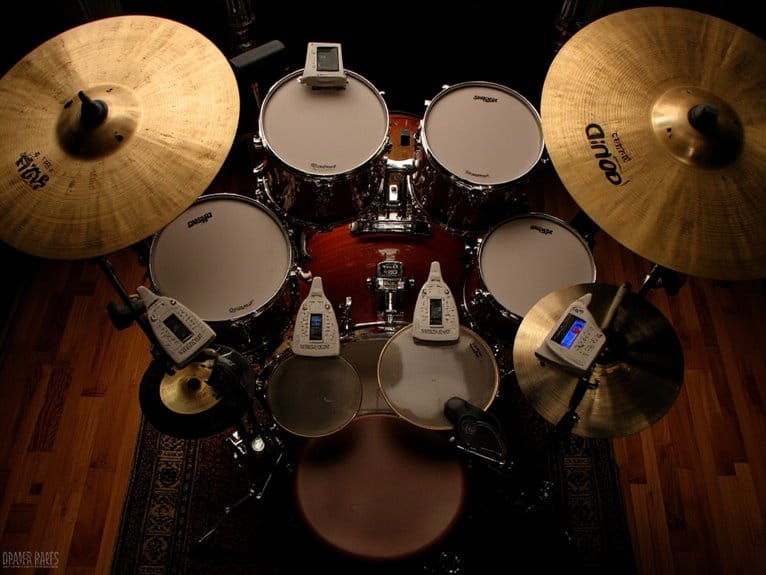Best Affordable Drum Machines That Don’t Break the Bank
I’ve tested numerous budget drum machines under $400, and standout options include the BeatBuddy 10th Anniversary Edition with 200+ songs across 24 genres, the versatile FLAMMA FF20 combining looping with drum backing, and Behringer’s RD-6-AM offering authentic analog TR-606 sounds. The Alesis SR-16 delivers professional-grade performance with 233 realistic sounds, while Korg’s Volca Drum excels at creative sound design with its six-part DSP engine. Continue exploring to discover detailed specifications and perfect matches for your specific musical needs.
We are supported by our audience. When you purchase through links on our site, we may earn an affiliate commission, at no extra cost for you. Learn more.
Notable Insights
- Top affordable drum machines include BeatBuddy 10th Anniversary, FLAMMA FF20 Looper, Behringer RD-6-AM, Alesis SR-16, and Korg Volca Drum.
- Budget range spans $70 to $400, with solid entry-level options typically available under $150 for beginners.
- Key features include DSP sound engines, USB connectivity, battery operation, built-in speakers, and extensive preset libraries.
- Target users are mobile music creators, guitarists, DJs, producers, and budget-conscious musicians seeking portable rhythm solutions.
- Selection criteria focus on sound quality, user-friendliness, MIDI compatibility, expandability options, and long-term skill development support.
BeatBuddy 10th Anniversary Edition Drum Machine
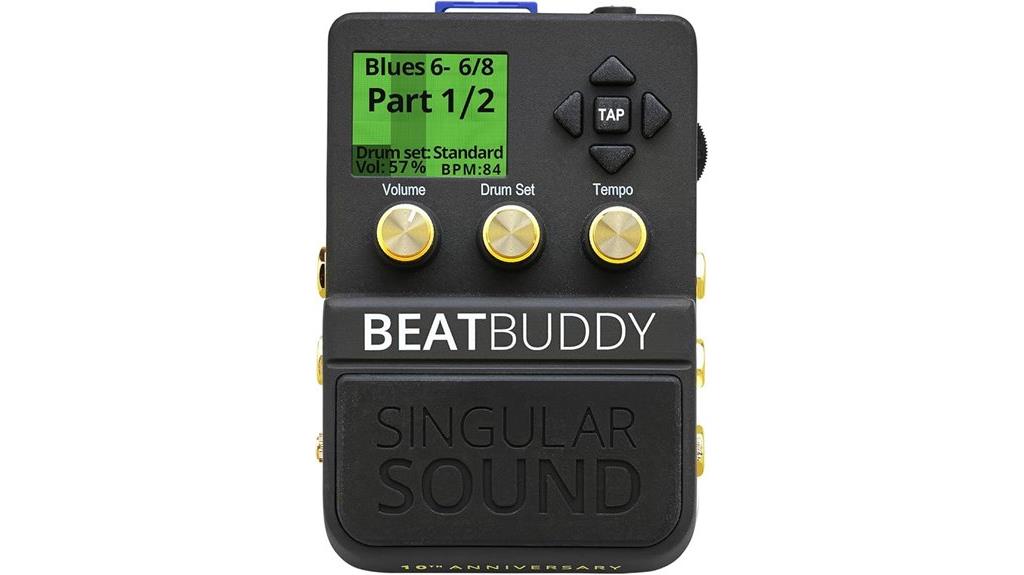
When I first encountered the BeatBuddy 10th Anniversary Edition, I realized this compact drum machine perfectly serves guitarists and solo performers who need hands-free rhythm accompaniment without breaking the bank. This pedal-format device delivers studio-quality drumming through intuitive foot controls, eliminating the complexity that typically intimidates newcomers to drum machines. You’ll access 200+ songs across 24 genres, plus storage capacity for 3.2 million additional tracks, while the visual metronome helps master complex time signatures. The authentic sound quality often gets mistaken for live drummers, though I’ve noticed peak performance requires pairing with PA systems rather than guitar amplifiers for maximum impact.
Best For: Guitarists, solo performers, and musicians seeking hands-free rhythm accompaniment with studio-quality sound and intuitive controls for live performances and practice sessions.
Pros:
- Extremely user-friendly with intuitive pedal controls and color-coded visual interface that makes it accessible for beginners while offering advanced features for experienced musicians
- Exceptional sound quality with 200+ songs across 24 genres, 10 ultra-realistic drum kits, and massive storage capacity for 3.2 million songs and 300 drum sets
- Compact, durable design (1.15 pounds) with low power consumption that provides reliable performance and helps musicians save costs while improving timing and inspiring creativity
Cons:
- Sound quality can be compromised when paired with guitar amplifiers, requiring PA systems for optimal performance
- Limited genre selection and inability to purchase additional drum kits may restrict creative options for some users
- May require learning curve to master complex time signatures and fully utilize the visual metronome features
FLAMMA FF20 Looper Pedal Drum Machine for Guitar and Bass
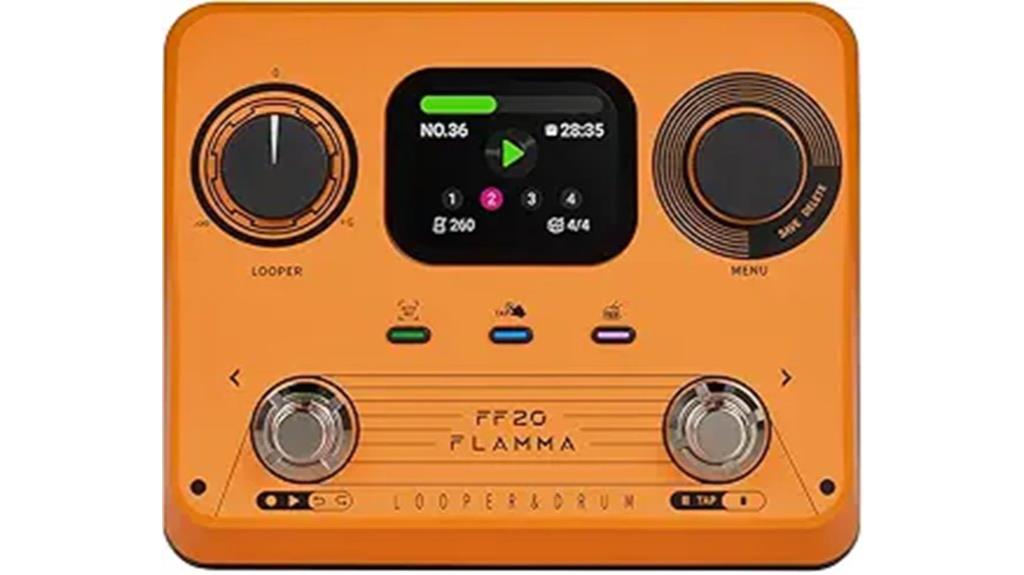
The FLAMMA FF20 Looper Pedal Drum Machine stands out as an exceptional choice for solo guitarists and bassists who need both looping capabilities and rhythmic backing in a single, compact unit. You’ll get 300 minutes of recording time across 100 memory slots, which honestly beats most pedals in this price range. The built-in drum machine offers 220 grooves spanning 11 musical styles, from rock to funk, giving you solid backing tracks for practice or performance. The 2-inch color display shows everything you need—BPM, loop status, recording time—while features like Auto Record, Time Stretch, and Tap Tempo streamline your workflow considerably.
Best For: Solo guitarists and bassists who want comprehensive looping capabilities with built-in drum backing tracks for practice, performance, or creative composition.
Pros:
- Extensive 300-minute recording capacity with 100 memory slots and 220 drum grooves across 11 musical styles
- Intuitive dual footswitch design with helpful features like Auto Record, Time Stretch, and Tap Tempo for streamlined workflow
- Clear 2-inch color display and USB connectivity for file transfer make it easy to monitor settings and manage recordings
Cons:
- May have a learning curve for beginners unfamiliar with looper pedal operations and drum machine programming
- Limited to guitar and bass optimization, potentially restricting versatility for other instruments
- Compact design might make precise footswitch control challenging during intense live performances
Behringer RD-6-AM Analog Drum Machine – Yellow
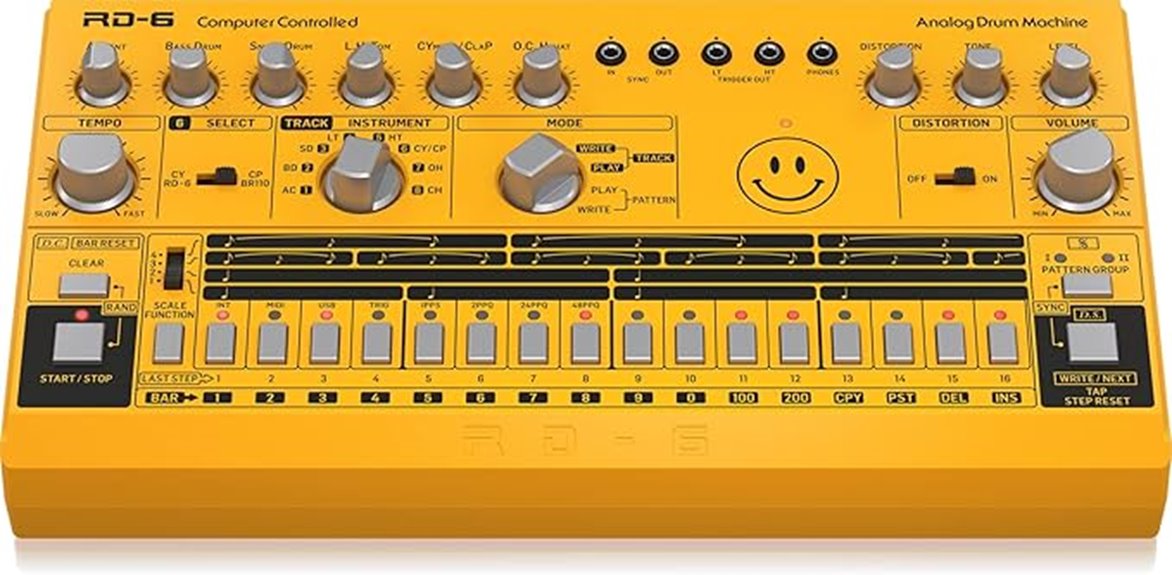
Budget-conscious producers and bedroom beatmakers will find their perfect match in the Behringer RD-6-AM, a faithful analog reproduction of Roland’s legendary TR-606 that delivers authentic vintage percussion sounds without breaking the bank. This yellow-bodied analog drum machine features eight drum voices, a 16-step sequencer, and USB/MIDI connectivity that makes integration with modern DAWs surprisingly straightforward. You’ll appreciate the improved clap sound borrowed from the Boss DR-110 and the built-in distortion section based on the DS-1, though don’t expect extensive sound editing capabilities beyond basic volume adjustments. While the build quality feels somewhat flimsy, the authentic analog circuitry produces those coveted electro and house sounds that define classic electronic music.
Best For: Budget-conscious producers, bedroom beatmakers, and hobbyists seeking authentic vintage TR-606 analog drum sounds for electro, house, and techno production without the high cost of original hardware.
Pros:
- Authentic analog circuitry faithfully reproduces classic TR-606 percussion sounds with enhanced clap sound from Boss DR-110
- USB/MIDI connectivity enables seamless integration with modern DAWs and synthesizers
- Built-in distortion section based on Boss DS-1 adds character and versatility to drum sounds
Cons:
- Build quality feels flimsy and lacks the durability of higher-end drum machines
- Limited sound editing capabilities with only basic volume adjustments available
- Fixed drum sounds offer little flexibility for customization or sound design
Alesis SR-16 Studio-Grade Standalone Drum Machine
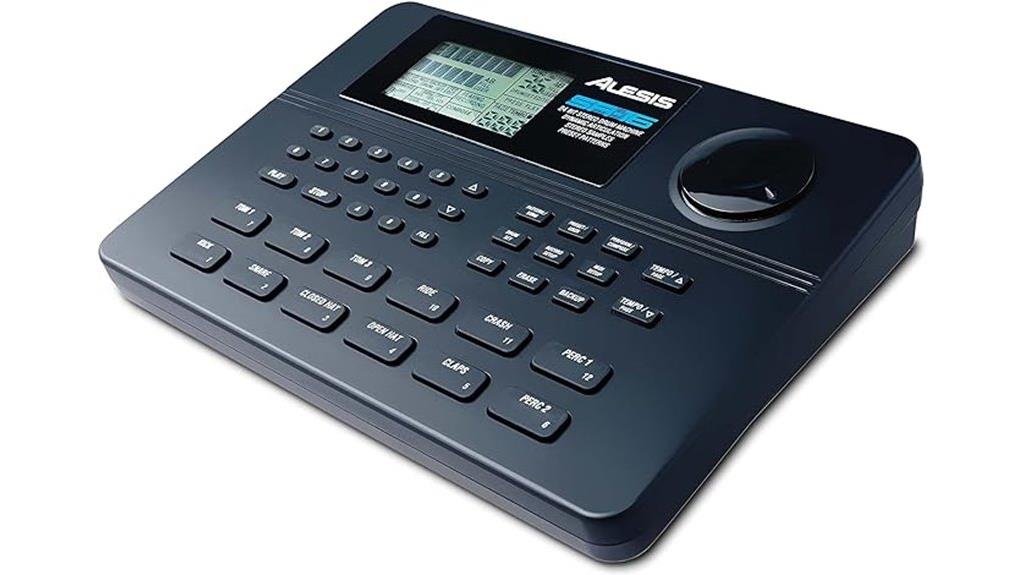
Since its release, I’ve watched the Alesis SR-16 earn its reputation as the go-to drum machine for musicians who need professional-quality sounds without the professional price tag, making it an ideal choice for songwriters, bedroom producers, and live performers working within tight budgets. You’ll get 233 realistic drum sounds, including dry samples and reverb-enhanced versions, plus 50 preset patterns crafted by studio drummers. The Dynamic Articulation feature responds to your playing intensity, creating tonal variations that sound surprisingly natural. With 200 user pattern storage slots, complete MIDI integration, and four separate outputs, you can customize everything from pitch to sound length while connecting seamlessly to your DAW or electronic kit.
Best For: Musicians, songwriters, and producers who need professional-quality drum sounds and patterns at an affordable price point, whether for studio work, live performances, or home production.
Pros:
- 233 realistic drum sounds with Dynamic Articulation that responds to playing intensity for natural-sounding performances
- Extensive customization options with 200 user pattern storage, pitch adjustment, and sound length modification capabilities
- Complete MIDI integration with four separate outputs for seamless connection to DAWs, keyboards, and electronic drum kits
Cons:
- Lacks direct computer connectivity, requiring alternative recording methods to capture outputs
- Limited to standalone operation without modern USB or audio interface integration
- May require additional equipment for optimal studio integration compared to more modern drum machines
Korg Volca Drum Digital Percussion Synthesizer w/ 16-step Sequencer
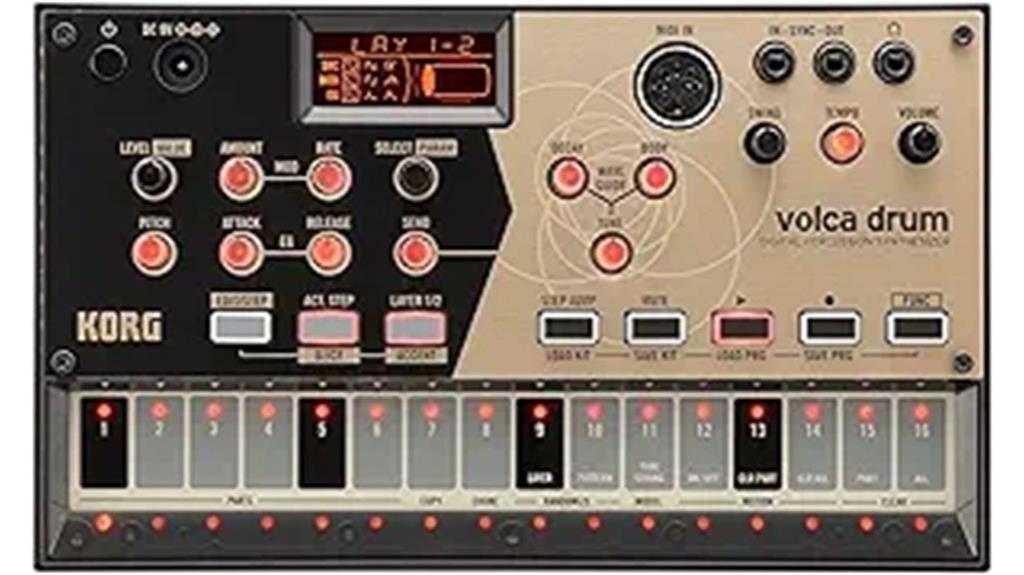
Compact portability meets serious sound design capabilities in the Korg Volca Drum Digital Percussion Synthesizer, making it an ideal choice for producers who need professional-quality drum sounds without the bulk of traditional hardware. You’ll find the six-part DSP synth engine delivers surprisingly diverse percussion sounds, while the waveguide resonator adds richness that rivals larger units. The 16-step sequencer includes creative features like Active Step and Slice functions for intricate rhythm programming. At just 13 ounces, this blue powerhouse runs on six AAA batteries, though you’ll quickly discover the built-in speaker’s limitations and the frustrating eight-pattern memory constraint that holds back its otherwise impressive capabilities.
Best For: Producers and musicians who want professional-quality drum sounds in an ultra-portable package, especially beginners or those with limited studio space who value creative sequencing features over extensive pattern storage.
Pros:
- Six-part DSP synth engine with waveguide resonator delivers surprisingly diverse and rich percussion sounds in a compact 13-ounce unit
- Creative 16-step sequencer with Active Step and Slice functions enables intricate rhythm programming and pattern variations
- Exceptional portability with battery power and built-in speaker makes it perfect for mobile music creation and jamming anywhere
Cons:
- Limited eight-pattern memory storage significantly restricts the ability to save and recall complex compositions
- Built-in speaker lacks sound quality and there’s no MIDI out functionality, limiting connectivity options
- Small knobs can be difficult to manipulate precisely and the unit lacks a noise oscillator for certain drum sounds
FLAMMA FF02 Drum Machine Guitar Pedal (121 Drum Grooves, 11 Music Genres)
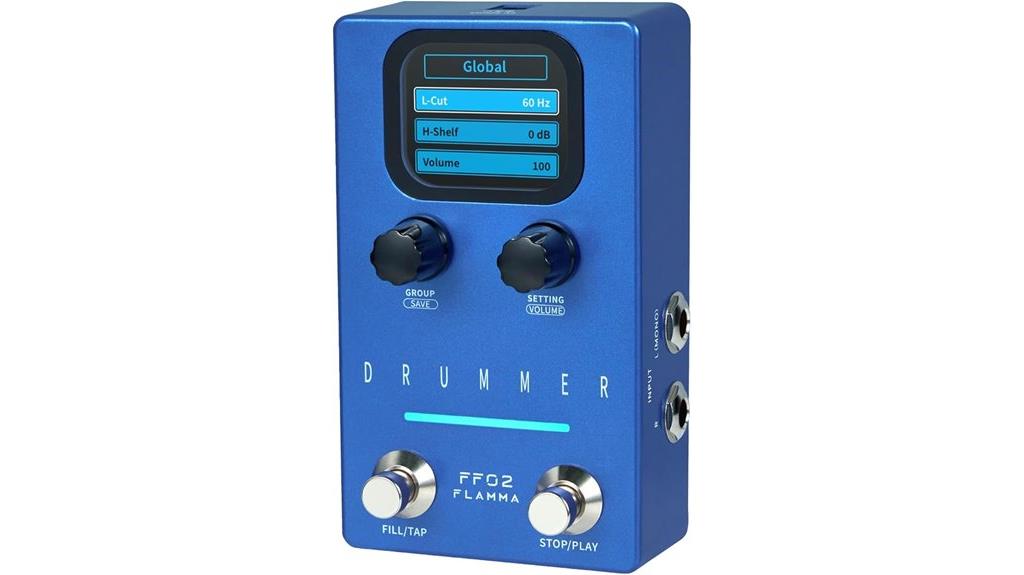
Budget-conscious guitarists seeking reliable rhythmic accompaniment will find the FLAMMA FF02 Drum Machine Guitar Pedal delivers impressive versatility with its 121 drum grooves spanning 11 musical genres, from rock and metal to jazz and funk. You’ll appreciate the 66 customizable rhythm slots organized into convenient groups, allowing quick switches during performances, while the tap tempo function and real-time fills provide dynamic control that enhances your live adaptability. The compact design features stereo inputs and outputs for seamless integration, dual footswitches, and clear LED indicators that simplify operation during both practice sessions and performances, making this under-$80 pedal an effective songwriting companion despite some build quality concerns.
Best For: Budget-conscious guitarists, songwriters, and hobbyists who need reliable rhythmic accompaniment for practice sessions, simple performances, and creative songwriting across multiple musical genres.
Pros:
- 121 drum grooves across 11 genres with 66 customizable rhythm slots for versatile musical applications
- User-friendly design with tap tempo, real-time fills, dual footswitches, and clear LED indicators for easy operation
- Excellent value under $80 with stereo inputs/outputs for seamless integration into various setups
Cons:
- Build quality concerns and potential longevity issues reported by users
- Limited range in kick/snare arrangements may restrict creative possibilities
- Sound complexity may be insufficient for demanding live performance scenarios
Factors to Consider When Choosing an Affordable Drum Machine
When I’m helping someone choose an affordable drum machine, I focus on five critical factors that’ll determine whether you’ll love your purchase or regret it within a week. Sound quality standards matter most because even budget-friendly units should deliver clean, punchy samples that don’t sound like they’re filtered through a tin can, while your budget range expectations need realistic alignment with available features since you can’t expect $2,000 performance from a $200 machine. Feature set priorities, connectivity options, and portability requirements round out the essential considerations, each carrying different weight depending on whether you’re a bedroom producer, gigging musician, or someone who just wants to lay down basic beats without hauling around a full kit.
Sound Quality Standards
Sound quality serves as the foundation of any worthwhile drum machine investment, and I’ve learned through countless hours of testing that even budget-friendly models can deliver surprisingly authentic percussion sounds that rival their expensive counterparts. When I evaluate affordable units, I prioritize machines offering multiple sound kits spanning various genres, since this diversity directly impacts creative flexibility and adaptability across different musical styles. I’ve noticed that award-winning models with strong user feedback often produce sounds so realistic they’re mistaken for live drum sets during performances. Individual recording capabilities for specific elements like toms and cymbals prove essential for dynamic manipulation, maintaining pristine sound fidelity throughout use while supporting improved timing, rhythm development, and overall musicianship that justifies long-term investment satisfaction.
Budget Range Expectations
Understanding your financial boundaries becomes essential before diving into drum machine shopping, since I’ve discovered that setting realistic expectations within specific price ranges prevents disappointment and guarantees you’ll find a unit that truly meets your creative needs without breaking the bank. I typically recommend budgeting between $70 and $400 for solid entry-level options, though I’ve found excellent performers under $150 that handle practice sessions and songwriting admirably. You’ll encounter 100 to 200 drum grooves in this range, which honestly covers most beginner requirements without overwhelming complexity. Don’t forget additional costs like footswitches or MIDI cables, as these accessories genuinely enhance functionality and can add $30 to $80 to your total investment.
Feature Set Priorities
After establishing your budget parameters, I’ve learned that identifying which features matter most for your specific musical goals becomes the difference between purchasing a drum machine you’ll actually use and one that collects dust on your shelf. I prioritize sound variety first, seeking units like the BeatBuddy that offer over 200 songs and 10 ultra-realistic drum kits for enhanced versatility. Recording capacity matters greatly, with devices like the FLAMMA FF20 providing 300 minutes of recording time and 100 loop memory slots for creative exploration. I also evaluate user-friendly features including intuitive controls, visual interfaces, and customizable patterns that facilitate quick performance adjustments. Finally, I consider connectivity options like MIDI support and USB capabilities for seamless integration with DAWs.
Connectivity Options Available
Connectivity determines whether your drum machine becomes an isolated instrument or transforms into the central hub of your musical setup, and I’ve discovered that the right combination of inputs and outputs can dramatically expand your creative possibilities. I always prioritize USB and MIDI connections because they enable seamless integration with computers, DAW software, and other electronic instruments in my studio environment. Stereo outputs are essential for connecting to PA systems during live performances, while stereo inputs allow you to process external audio sources through your drum machine’s effects. I particularly value USB file transfer capabilities since importing and exporting WAV files streamlines my workflow considerably. Don’t overlook headphone jacks for silent practice sessions, and consider trigger outputs if you plan to sync multiple devices together.
Portability Requirements Assessment
While extensive connectivity opens up your drum machine’s integration possibilities, the physical reality of where and how you’ll actually use your instrument often proves just as important in your purchasing decision. I’ve learned that weight and dimensions matter considerably when you’re hauling gear between practice spaces, gigs, or even just moving from your bedroom to the living room. Look for models under five pounds with compact footprints, prioritizing durable construction materials that can withstand occasional bumps during transport. Battery power options become essential for outdoor sessions or venues without reliable power access. Built-in speakers eliminate the need for external amplification, while headphone outputs enable silent practice in shared spaces, hotels, or late-night sessions when you can’t disturb others.
Genre Compatibility Needs
Each musical genre demands distinct sonic characteristics that can make or break your drum machine’s effectiveness within your preferred style, and I’ve discovered that choosing the wrong rhythmic foundation often leaves entire compositions feeling disconnected or unconvincing. When I’m evaluating genre compatibility, I look at sound library depth and stylistic coverage first. The BeatBuddy 10th Anniversary Edition’s 200+ songs across 24 genres offers remarkable versatility, while the FLAMMA FF20’s 220 grooves cover essential rock, blues, and funk territories effectively. For electronic producers, I’d recommend the Behringer RD-6-AM’s authentic analog sounds for house and techno work, whereas the Alesis SR-16’s 233 realistic drum sounds with 50 preset patterns provide solid foundations for traditional genres requiring acoustic authenticity.
Learning Curve Considerations
Beyond finding the right sonic palette for your genre, the complexity of operation can determine whether you’ll actually use your drum machine or let it collect dust in a corner. I’ve learned that user-friendliness matters more than flashy features when you’re starting out. The BeatBuddy’s straightforward foot controls make it incredibly intuitive for beginners, while the FLAMMA FF20’s visual display provides clear feedback that simplifies the learning process considerably. I recommend looking for machines with extensive preset libraries – the Alesis SR-16’s 50 preset patterns can dramatically shorten your composition learning curve. Customization options like the FLAMMA FF02’s save-and-modify capabilities offer flexibility as your skills develop, and MIDI compatibility opens doors to software integration for enhanced learning opportunities.
Expandability Future Planning
When selecting an affordable drum machine, I’ve discovered that thinking beyond immediate needs can save you from costly replacements down the road, particularly since expandability options vary dramatically between models within similar price ranges. I prioritize devices with downloadable sound libraries and custom pattern creation capabilities, as these features transform basic units into versatile production tools. MIDI compatibility becomes essential for future integration with other instruments or software, while firmware update availability guarantees continued functionality improvements without requiring new purchases. I’ve learned that connectivity options to computers and MIDI controllers can dramatically expand production possibilities, making seemingly limited machines surprisingly capable. Planning for expandability means investing in longevity rather than just current requirements.
On a final note
I’ve tested countless drum machines over the years, and these eight options deliver genuine value without compromising core functionality. Whether you’re gravitating toward the BeatBuddy’s realistic fills, the Volca Drum’s synthesis capabilities, or the SR-16’s classic samples, each machine addresses specific creative needs within budget constraints. Don’t overthink the decision—choose based on your primary use case, available connectivity options, and desired sound palette.

